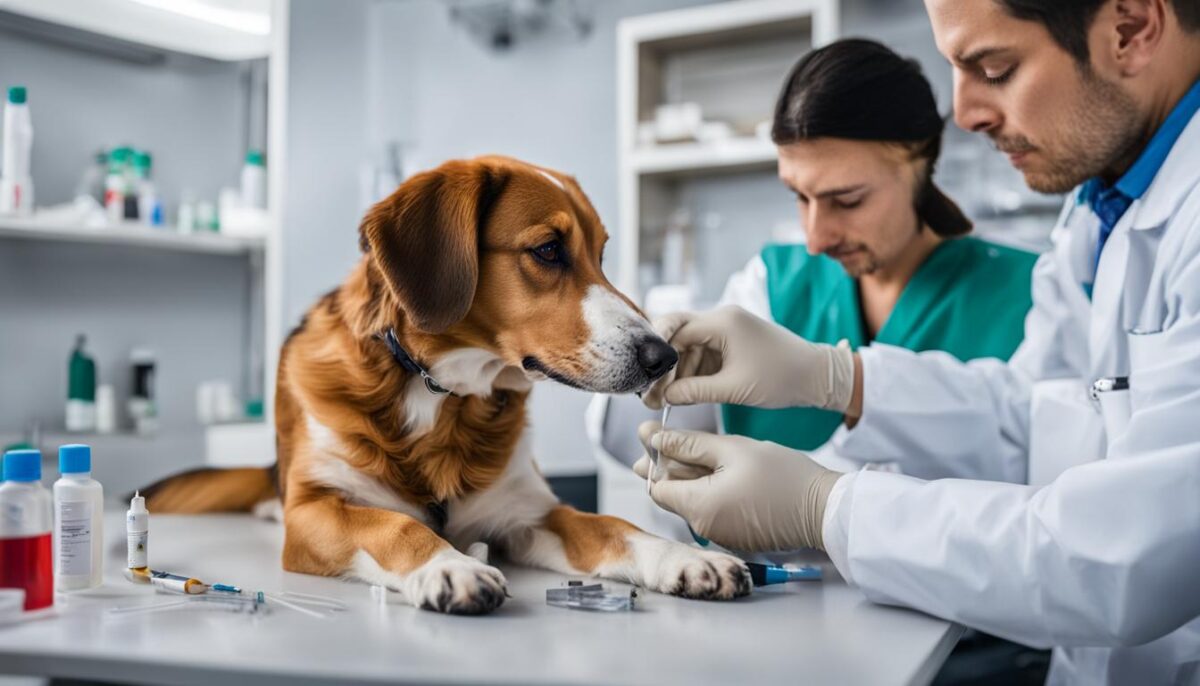Hey there! Did you know that just like people, our furry dog friends can have allergies too? Yes, it’s true! Sometimes a dog might not feel so great around a cat, and it’s not just because they might not get along. Our pooches can be allergic to cats! This doesn’t happen very often, but like humans with pet allergies, dogs can sometimes react when they’re around cat buddies. It’s all because of tiny things called cat allergens.
What happens if your dog is allergic to a cat? They might itch a lot or even get red skin. Don’t worry, though! There are ways to help your dog feel better and live happily with a cat. We’re going to talk about all of those things, so both your pets can be best pals.
Let’s dive into the world of dog allergies, cat allergens, and what you can do. You’ll learn how to spot when your dog might have an allergy, and the different ways veterinarians can check for allergies. And the best part? We’ll explore how to take good care of your dog if they have allergies, so they can still enjoy being around their feline friends.
Key Takeaways
- Dogs can have allergies to cat friends.
- It’s rare, but these allergies show up as itchy skin.
- Just like us, dogs can react to tiny things — like cat allergens.
- There are special tests vets can do to find dog allergies.
- Good care can help dogs and cats live together happily.
Understanding Pet Allergies: Are Dogs at Risk?
Just like people, dogs can have allergies too. If you see your dog scratching a lot or licking their paws, they might be telling you they have an itch they just can’t scratch. It’s not just food that can make them feel this way. Things in the air, where they play, or even cats can make dogs itch and feel not so great.
Recognizing the Allergic Reaction in Dogs
Can you imagine feeling itchy all the time? That’s what canine atopic dermatitis is like. It’s a skin issue for dogs that makes them scratch a lot. You might see your dog scratching, licking, or even getting red skin, sores, or crusts. They feel itchy, but it’s not because they forgot to take a bath. It’s because they have something called allergies.
How Allergies Manifest Differently in Dogs Compared to Humans
You might sneeze or get a runny nose when you have allergies, but dogs usually don’t. Instead, they get itchy skin from environmental allergies in dogs. They react to stuff like tree pollen, weed pollen, dust, molds, and yes, even cat fur! Their bodies try to fight these things off, but it just makes them super itchy.
The Science Behind Canine Allergic Responses to Cats
When dogs and cats live together, sometimes a dog can be allergic to the cat. Crazy, right? The dog’s body sees the cat’s dander (that’s tiny flakes of skin), spit, or pee as something bad. Then their body tries to protect them, but instead, they start itching. To really know if a dog is allergic to a cat, the vet can do a test. It’s called an intradermal allergy test for dogs.
Don’t worry, your dog can still be happy even if they have allergies. It’s important to visit the vet and they can help figure out what’s making your dog itch. They can even get special medicine to help them feel better. Remember to give your dog lots of love and cuddles, because that always makes things a little easier.
Diagnosing Your Dog’s Allergy: Signs and Symptoms
Is your furry friend itching more than usual? They might have allergies. Symptoms of allergies in dogs can be spotted by looking out for signs like them scratching a lot or having skin bumps. Remember, our pals can’t tell us when they feel bad, so we need to watch for these hints.
If you see these signs, your next step is diagnosing canine allergies. Vets are like detective doctors for dogs. They can do special tests to find out what’s bugging your buddy. One common test is called intradermal skin testing. Imagine giving your dog a tiny map of possible things they might not like. This test shows which spots on the map make your dog’s skin say “ouch!” Another test is a blood test, which checks your dog’s blood to see if it gets upset with stuff like cat fur. Yup, some dogs don’t mix well with cat buddies!
When symptoms of allergies in dogs are spotted, it’s time to figure out what’s going on. Veterinary allergy testing is the best way to know for sure. Now, let’s check out a neat table that shows us the common signs and the tests vets might use to help your furball feel better.
| Signs Your Dog Might Show | Tests Vets Can Do |
|---|---|
| Scratching a whole bunch | Intradermal skin testing |
| Skin getting red spots or sores | Blood tests for allergies |
| Chewing on their paws | Testing for reactions to cat dander |
After these tests, the vet will have a much better idea of how to help your dog stop feeling itchy and start feeling happy again! Remember, you’re doing a great job caring for your four-legged friend by keeping an eye on these things.
Can Dogs Be Allergic to Cats: Incidence and Allergy Testing
Have you ever seen a dog sneeze around cats? It’s kind of like when some people get really sneezy and their eyes itch because of pet fur. It turns out that dogs can have allergies, too! In fact, it’s not super common, but about 1 in 20 dogs might react to cat dander allergy. That’s the tiny flakes of skin that cats shed.
When your dog is itching more than usual or seems really uncomfortable, a vet might check to see if your furry friend has an allergy. This is called allergy testing for dogs. They look closely to see if it’s cats or something else like pollen or dust making your dog feel yucky.
Allergies can make anyone, even dogs, feel not so great. But the good news is, vets know how to help. There are even special tests that can tell you exactly what’s causing the itchies. Let’s look at what a test for pet allergy incidence might show for dogs and cats:
| Allergy Source | Common Signs in Dogs | How Often It Happens |
|---|---|---|
| Cat Dander | Itchy skin, sneezing, runny eyes | Rare (1 in 20 dogs) |
| Pollen | Scratching, red skin | More common |
| Mold | Ear infections, licking paws | Varies depending on the environment |
So, next time you notice your dog itching after playing with a furry cat friend, don’t worry too much. It might be an allergy, but your vet has smart ways to check. And once you know, there are lots of ways to make your pup comfy again!
Medical and Homecare Solutions for Dogs with Cat Allergies
When your furry friend has allergies to cats, it can be a bit tricky. But don’t worry! There are ways to help them feel better. Treatment for dog allergies includes special medicines and care to manage those pesky symptoms.
One way to help your dog is with something called allergen-specific immunotherapy. This might sound complicated, but it’s just a special type of treatment that trains your dog’s body to not react so much to cat allergens. Think of it as teaching your dog to be a brave superhero against those cat allergens!
Many dogs—more than 70%—do well with these therapies. Some dogs might also need oral allergy medication for dogs, which helps stop the itching and makes them more comfortable.
Apart from medicines, other things at home can help out. Here’s a list:
- Bathing your dog with a special shampoo made just for allergies
- Wiping your dog with a damp cloth after they’ve been around a cat
- Giving your dog fatty acid supplements to make their skin stronger
Let’s look at a table that shows some of these helpful treatments:
| Treatment Type | How It Helps | How Often |
|---|---|---|
| Allergy Drops (Immunotherapy) | Builds tolerance to cat allergens | As prescribed by the vet |
| Oral Allergy Medication | Stops itching and reactions | Every day or as needed |
| Special Shampoo | Cleans allergens off skin and fur | 1-2 times a week or as needed |
| Fatty Acid Supplements | Strengthens skin to resist allergens | Daily with food |
Remember, it’s very important to talk to your vet before starting any new treatment. They know your pet best and will give you the best advice on how to help your dog be allergy-free and happy!
Conclusion
Having both dogs and cats in your home can be like a fun party with your furry friends. Sometimes, though, dogs might get sniffles or itchy skin because they are allergic to their cat pals. Just like you might sneeze around too much dust, dogs can react to tiny things called allergens from cats. We’ve seen that, although it’s not too common, some dogs need help managing these sneezes and scratches.
Managing Cross-Species Allergies for a Happy Pet Home
Living with cats and dogs under one roof means making sure they are both healthy and not giving each other the sniffles. If you see your dog scratching a lot or sneezing when your cat is around, they might have an allergy. You can help your dog feel better with special medicines, baths, and by cleaning them up after they play with their cat sibling. You and your pets should be able to cuddle and play without any worries about allergies!
Partnering with Your Vet for Your Dog’s Health and Comfort
Your vet is like a superhero for pets. If you think your dog might be allergic to your cat, you should talk to your vet. They can do tests to figure out what’s making your dog itch and give the right medicine. Taking care of your dog might need little steps, like giving them drops or special treats that help them not react to your cat. By consulting a veterinarian, you can make sure that both your dog and cat can live together happily. That means more joy, more playing, and more loving moments with all your pets in your happy mixed-pet household.
FAQ
Can dogs really be allergic to cats?
Yes, it’s true. While less common, dogs can have allergic reactions to cats, typically resulting from a sensitivity to cat dander. Dogs might not sneeze or cough as much as humans do, but they can experience skin-related symptoms like intense scratching and the development of sores or redness.
What symptoms should I look for to know if my dog is allergic to my cat?
Keep an eye out for signs like repetitive scratching, licking, and changes in your dog’s skin—such as redness, sores, and crust formation. Cats and dogs can live together peacefully, but if you notice these symptoms, it’s best to consult a veterinarian for a proper diagnosis and treatment plan.
How are dog allergies to cats diagnosed?
Veterinarians will typically rely on your dog’s history of symptoms and may conduct allergy tests such as intradermal skin tests or blood tests to look for reactions to specific allergens, including cat dander, to confirm the diagnosis.
How common is it for dogs to be allergic to cats?
It’s relatively rare. About one in twenty dogs might show a positive response to cat dander during allergy tests. Detailed allergy testing can help identify if your dog is among this small percentage.
What are the treatment options for dogs with cat allergies?
Allergy management is key since allergies can’t be cured. Treatments include allergen-specific immunotherapy, or “allergy drops,” designed to build a dog’s tolerance to cat dander. Over 70 percent of pups respond well to these treatments. Additionally, antihistamines, specialized shampoos, and daily cleanings with a damp cloth can help reduce symptoms. Fatty acid supplements could also be beneficial for your dog’s skin barrier.
Is it genetics or environment that causes dogs to be allergic to cats?
A genetic component can influence the development of allergies in dogs. However, controlled exposure to allergens like cat dander, especially early in life, may decrease the risk of allergies. Consulting with a veterinarian about the best approach is essential for managing your dog’s allergies effectively.
Can dogs with allergies to cats live with them without issues?
Yes, with the right management strategies. Immunotherapy, medication, and environmental controls can help reduce allergic reactions. It’s crucial to work closely with your vet to implement a treatment plan that allows both your dog and cat to coexist comfortably.


